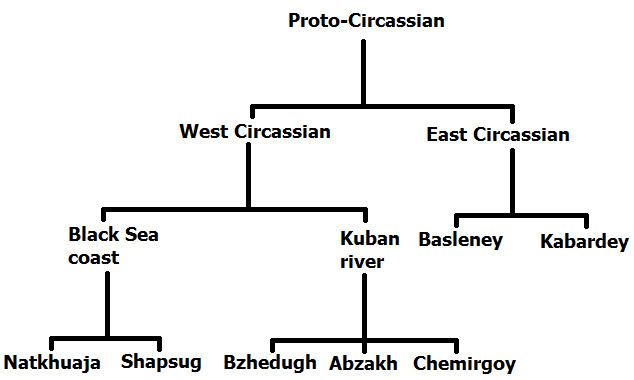 | ||
Proto-Circassian (or Proto-Adyghe) is the reconstructed common ancestor of the Circassian language which has two written dialects, Lowland Adyghe (Circassian: КӀах адыгабзэ) and Kabardian Adyghe (Circassian: Къэбэрдей адыгэбзэ).
Contents
- Vocalism and accent
- Consonants
- Bilabial stops and
- Alveolar stops and
- Alveolar affricates and
- Alveolo palatal affricates and
- Palato alveolar affricates and
- Retroflex affricates and
- Palato alveolar stops and
- Palato alveolar fricative and
- Labialized palato alveolar and
- Labialized velar fricatives and
- Uvular affricates
- Lateral affricates
- Glottal stops
- Palatalized velar fricative
- References
Vocalism and accent
In bisyllabic roots, two possible places of accent are reconstructed, with the following development of structures in descendant languages:
In other words, Lowland Adyghe retains the distinction between *a and *ǝ in the 2nd syllable, if it was originally stressed; the 2nd syllable vowel is dropped in originally unstressed syllables. Kabardian Adyghe retains the distinction uniformly, by dropping *ǝ but not *a. Both groups retain the quality distinction in the first syllable, and additionally display a long vowel in roots of the original shape *CaCa (regardless of stress).
Consonants
The consonant system is reconstructed with a four-way phonation contrast in stops and affricates, and a two-way contrast in fricatives.
Bilabial stops пʰ, п, б and пӏ
Alveolar stops тʰ, т, д and тӏ
Alveolar affricates цʰ, ц, дз and цӏ
Alveolo-palatal affricates чьʰ, чь and чӏь
Proto-Circassian plain voiceless alveolo-palatal affricate чь [t͡ɕ] also become чъ [t͡ʂ] in the Temirgoy and Bzhedug sub-dialects, ш [ʃ] in the Abzakh sub-dialect but ж [ʒ] in the Kabardian Adyghe dialect.
Palato-alveolar affricates чʰ, ч, дж and кӏ
Retroflex affricates чъʰ, чъ, джъ and чӏ
Palato-alveolar stops кьʰ, кь, гь and кӏь
In the Proto-Circassian language there exist a palatalized voiced velar stop [ɡʲ] ⟨гь⟩, a palatalized aspirated voiceless velar stop [kʰʲ], a palatalized voiceless velar stop [kʲ] ⟨кь⟩ and a palatalized velar ejective [kʲʼ] ⟨кӏь⟩. The consonants гь [ɡʲ], кь [kʲ] and кӏь [kʲʼ] survive in the Shapsug dialect (e.g. Kfar Kama dialect), in the Besleney sub-dialect and in the Uzunyayla sub-dialect. In other Circassian dialects they were merged with the palato-alveolar consonants дж [d͡ʒ], ч [t͡ʃ] and кӏ [t͡ʃʼ] respectively. Proto-Circassain unaspirated кь [kʲ] become гь [ɡʲ] in Besleney sub-dialect and Uzunyayla sub-dialect and it become дж [d͡ʒ] in the other Kabardian Adyghe sub-dialects (кь [kʲ] → гь [ɡʲ] → дж [d͡ʒ]).
Palato-alveolar fricative шʰ, ш, ж and шӏ
Labialized palato-alveolar цу, су, зу and сӏу
The Proto-Circassian language did not had labiodental consonants (ф [f] and в [v]). There existed a series of labialized alveolar sibilant affricates and fricatives: *[tsʷ] ⟨цу⟩, *[sʷʼ] ⟨сӏу⟩, *[sʷ] ⟨су⟩, *[zʷ] ⟨зу⟩. In Adyghe Temirgoy dialect they became *[tsʷ] ⟨цу⟩, *[ʃʼʷ] ⟨шӏу⟩, *[ʃʷ] ⟨шъу⟩, *[ʒʷ] ⟨жъу⟩. In Shapsug, Bzhedug and Abzakh dialects of Adyghe they become labiopalatalized *[tɕʷ] ⟨чъу⟩, *[ʃʼʷ] ⟨шӏу⟩, *[ʃʷ] ⟨шъу⟩, *[ʒʷ] ⟨жъу⟩, and in Kabardian they become labiodental consonants *[v] ⟨в⟩, *[fʼ] ⟨фӏ⟩, *[f] ⟨ф⟩, *[v] ⟨в⟩.
Labiodental [f] ⟨ф⟩ is found also in Adyghe, but there it derives from the Proto-Circassian labialized voiceless velar fricative [xʷ] ⟨ху⟩, which survived in the East Circassian dialects (e.g. Kabardian and Besleney).
Labialized velar fricatives кʰу, ку, гу and кӏу
Uvular affricates
The consonant aspirated voiceless uvular stop [qʰ] ⟨къʰ⟩ and its labialized counterpart [qʰʷ] ⟨къʰу⟩ survived in Bzhedug. In the Temirgoy sub-dialect they become къ [q] and къу [qʷ] while in some Shapsug sub-dialects they become хъ [χ] and хъу [χʷ]. In Kabardian Adyghe they became affricate voiceless uvular affricate [q͡χ] ⟨кхъ⟩ and labialized voiceless uvular affricate [q͡χʷ] ⟨кхъу⟩.
Lateral affricates
In the Proto-Circassian there existed an alveolar lateral ejective affricate *[t͡ɬʼ]. This consonant survived in the Besleney sub-dialect of the Kabardian Adyghe dialect. In most Circassian dialects it become an alveolar lateral ejective fricative [ɬʼ].
There also existed voiced alveolar lateral affricate *[d͡ɮ] that become [ɣ] in Adyghe and [ʒ] in Kabardian and a palatalized voiced velar fricative *[ɣʲ] that become [ɣ] in Lowland Adyghe and [ʑ] in Kabardian Adyghe.
Glottal stops
The consonants glottal stop [ʔ] and labialized glottal stop [ʔʷ] in Proto-Circassian may have come from uvular ejective [qʼ] and labialized uvular ejective [qʷʼ]. In the Hakuchi sub-dialect it is pronounced as [qʼ] and [qʷʼ].
